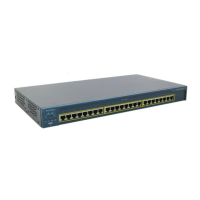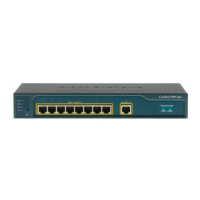1-3
Catalyst 2950 and Catalyst 2955 Switch Software Configuration Guide
78-11380-12
Chapter 1 Overview
Features
–
Accomplishing multiple configuration tasks from a single window without needing to
remember command-line interface (CLI) commands to accomplish specific tasks.
–
Interactive guide mode that guides you in configuring complex features such as VLANs, ACLs,
and quality of service (QoS).
–
Automated configuration wizards that prompt you to provide only the minimum required
information to configure complex features such as QoS priorities for video traffic, priority
levels for data applications, and security.
–
Downloading an image to a switch by using TFTP.
–
Applying actions to multiple ports and multiple switches at the same time, such as VLAN and
QoS settings, inventory and statistic reports, link- and switch-level monitoring and
troubleshooting, and multiple switch software upgrades.
–
Viewing a topology of interconnected devices to identify existing switch clusters and eligible
switches that can join a cluster and to identify link information between switches.
• Real-time status monitoring of a switch or multiple switches from the LEDs on the front-panel
images from the device manager and from Network Assistant.
• Switch clustering technology for
–
Unified configuration, monitoring, authentication, and software upgrade of multiple switches
(see the release notes for a list of eligible cluster members).
–
Automatic discovery of candidate switches and creation of clusters of up to 16 switches that can
be managed through a single IP address.
–
Extended discovery of cluster candidates that are not directly connected to the command switch.
Note For the Network Assistant software requirements, and for more information about
clustering, see the Getting Started with Cisco Network Assistant, available on Cisco.com.
For clustering requirements, including supported Cisco IOS releases, see the release notes
for this release.
• Hot Standby Router Protocol (HSRP) for command-switch redundancy. The redundant command
switches used for HSRP must have compatible software releases.
Performance
• Autosensing of speed on the 10/100 and 10/100/1000 ports and autonegotiation of duplex mode on
the 10/100 ports for optimizing bandwidth
• IEEE 802.3x flow control on Gigabit Ethernet ports operating in full-duplex mode
• Fast EtherChannel and Gigabit EtherChannel for enhanced fault tolerance and for providing up
to 2 Gbps of bandwidth among switches, routers, and servers
• Support for frames larger than 1500 bytes. These switches support frame sizes from 1500 to
1530 bytes:
–
Catalyst 2950G-12-EI, 2950G-24-EI, 2950G-24-EI-DC, and 2950G-48-EI switches running
Cisco IOS Release 12.1(6)EA2 or later
–
Catalyst 2950 LRE switches
–
Catalyst 2955 switches

